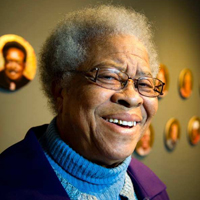

Mary Ann Carroll is the only woman of the twenty-six Highwaymen Florida Artists Hall of Fame awardees. While many of the painters stopped making landscapes after Alfred Hair died, Carroll kept on painting as she needed the money to raise her seven children, especially after her husband left her. At that time, her youngest child was five years old. “It wasn’t easy,” she said, “but I didn’t look at it as being hard. You do what you have to.”
She was born to a sharecropping family in Georgia. Her mother taught her to be obedient, once beating her with a peach tree branch. In turn, Carroll also taught her children to be obedient, but she never whipped them. Her grandmother taught her how to work hard. She learned that money grows on trees, but you have to pick it off. The best of times were during harvest season, but because she didn’t know anything else, she thought that life was pretty good all the time. Now, when she looks back at here early years she knows her family had rough times.
Mary Ann’s religious faith came early. She remembers going to a tent service with her sister at an early age that sealed her connection to God. She now ministers at a “hole in the wall” church, explaining, “No one gets a salary at Foundation Revival Center, Church of Redemption. We just keep it going so the door can stay open.” Mary Ann Carroll walks with God through every challenge.
Mary Ann never had formal training in art. The closest she came was in a science class; she remembers drawing a thermometer. The teacher was so impressed she posted it on the bulletin board. Mary Ann says that this was her first art exhibition.
Harold Newton taught her to paint. She was drawn to him because he had a car with flames painted on it, and she liked things that were different. She was about 16 when she first saw him painting on 20th Street and Avenue D. He was painting a brilliant red Poinciana tree on Avenue Q a few days later. While she had drawn with pencil before, Newton’s colorful images intrigued her. She also knew that Harold made money selling his artwork. So Mary Ann asked him to teach her how to paint. Obliging, he showed her how to mix colors and make frames. She then practiced these newfound skills at home.
Mary Ann quickly got to know other painters in Fort Pierce because she was one of the few artists who had a car and could make selling on the highway possible. Her first road trip was with Livingston Roberts and a few other painters. They went to Melbourne and sold out at the first medical building they visited on US 1. Both she and Livingston peddled four paintings. Stunned and exhilarated to have earned $70, she began learning negotiating skills.
Sometimes Al Black sold her paintings. In the 1960s when she earned $100, she’d feel rich; it was substantially more money than she made at other jobs.
Although she was fearful to sell on the road alone, she did it because she had to. Stashing a gun in the glove compartment, she traveled as far as Jacksonville. She knew there was racial unrest throughout Florida, and people didn’t always treat her well. Out of necessity, she sometimes took some of her children with her, but they were instructed to stay in the car.
